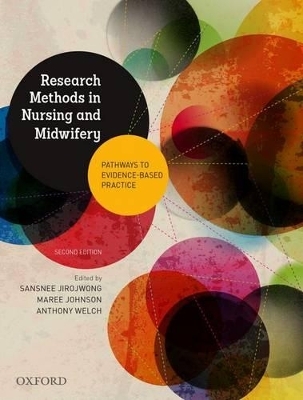
Research Methods in Nursing and Midwifery: Pathways to Evidence-based
OUP Australia and New Zealand (Verlag)
978-0-19-552851-0 (ISBN)
This user-friendly text is rich with learning support for nursing and midwifery students, including easy-to-read flowcharts, practical examples and tips, practice exercises and additional resources to expand their knowledge of the research process and methodology. Research Methods in Nursing and Midwifery helps students to think critically, develop problem-solving skills and learn to apply research to the practical aspects of nursing.
Sansnee Jirojwong has previously taught nursing and midwifery students at Australian universities including the University of Western Sydney and currently assists junior researchers with projects in her native Thailand. Maree Johnson is the Director of the Centre for Applied Nursing Research, University of Western Sydney and the South Western Sydney Local Health District. Anthony Welch is an Associate Professor in the School of Nursing and Midwifery, Central Queensland University.
PART 1: GETTING STARTED IN RESEARCHChapter 1. The Importance of Research in Nursing and Midwifery Sansnee Jirojwong and Anthony WelchThe place of research in generating knowledge The importance of evidence-based nursing and midwifery practices The purposes of research Inductive and deductive reasoning in researchParadigms for nursing and midwifery research The role of theory in nursing and midwifery research What is the purpose of theory for research and evidence-based practice? The future use of nursing and midwifery theories and frameworks in research Developments in Australian nursing and midwifery research Looking ahead: Research and its application in nursing and midwifery care SummaryChapter 2. Evidence-based Practice for Nurses and MidwivesMaree Johnson and Ritin Fernandez Skills required for evidence-based practiceWhy evidence-based practice?Do nurses participate in evidence-based practice?Working together works well in EBPWhere do you find the evidence?Barriers to EBPDeveloping an evidence-based professionChapter 3. Introducing the Research ProcessMaree Johnson and Cecily Hengstberger-Sims Planning the ResearchStep 1: Select the topic and the research questionStep 2: Review and synthesise the literatureStep 3: Identify a frame of reference and/or define the termsStep 4: Develop aims, objectives, research questions and hypothesesStep 5: Choose appropriate methods to address the research questions or hypothesesStep 6: Defining the significance and outcomes of the researchStep 7: Consider the feasibility and ethical issuesStep 8: Finalise the research proposal planAppendix 3.1 Example of a Quantitative Research ProposalAppendix 3.2 Example of a Qualitative Research ProposalChapter 4. Ethical and Legal Considerations in Research Keri ChaterHistory of ethics committees Roles of research councils and the conduct of health research Ethical principles and research conductData management throughout the research study and beyondVulnerable groups and power relationships between researcher and participantAppendix 4.1: Example of a Plain Language Statement and Consent Form PART 2: QUALITATIVE RESEARCH METHODSChapter 5. Sampling in Qualitative ResearchAnthony WelchWhat is sampling?Sampling methods in qualitative researchBias in samplingChapter 6. Qualitative Research DesignAnthony WelchWhat is qualitative research?The types of qualitative researchChapter 7. Data Collection: Qualitative ResearchAnthony Welch and Sansnee JirojwongPreparing for the process of data collectionChoosing a mode(s) for data collectionTriangulation in data collectionRigour and trustworthinessChapter 8. Qualitative Data AnalysisLisa WhiteheadThe stages of qualitative analysisTheories and methodsAnalysing visual dataBuilding trustworthiness in qualitative data analysisComputer software packages for qualitative analysisCodingData searching and retrievalDeveloping and testing theoryAppendix 8.1 Example of data analysisPART 3: QUANTITATIVE AND MIXED METHODS RESEARCHChapter 9. Sampling in Quantitative ResearchMaree Johnson and Sungwon ChangPopulations and samplesProbability sampling and non-probability samplingDifferent sampling approaches in quantitative studiesBias in sampling Sample sizeAppendix 9.1: A Random Numbers Table Chapter 10. Quantitative Research DesignSansnee Jirojwong and Karen Pepper What is quantitative research design?Quantitative research and causalityChoosing a quantitative research designTypes of quantitative research designsAppendix 10.1 CONSORT 2010 checklist of information to include when reporting a randomised trialChapter 11. Data Collection: Quantitative Research Jan Taylor and Jamie RanseData collection methods Surveys Interviews Observation Choosing an existing instrument or scale Chapter 12. Quantitative Data Analysis Petra Buettner, Reinhold Muller and Monika Buhrer-SkinnerWhy statistics? Descriptive versus comparative statistics Descriptive statistics Inferential statistics Use of computer programs for data analysis Appendix 12.1: Read and understand statistics in a published articleAppendix 12.2: Analyse a small data set using GraphPad’s QuickCalcs onlineChapter 13. Mixed Methods Research Janice LewisWhy conduct mixed methods research? Differences between quantitative and qualitative research methods Views of mixed methods research Incompatibility thesis Pragmatism and mixed methods Status of quantitative and qualitative elements Mixed methods as a continuum Mixed methods design Sampling techniques for mixed methods studies Analysis of mixed methods data Issues of validity in mixed methods research The future of mixed methods research PART 4: PATHWAYS TO EVIDENCE-BASED PRACTICEChapter 14. Critical Review of ResearchJane Warland and Phil MaudeSelection and effective reading of the literatureCritical appraisal and consideration of the level of available evidenceBecoming familiar with the process of critical reviewRead reviewers’ comments from open-access published journalsRead critical reviews posted on the internetCritique methodsChapter 15. Undertaking a Systematic Review Ritin Fernandez, Maree Johnson and Rhonda GriffithsIntroduction The process of a systematic review Planning the review Developing the protocol Conducting the systematic review Data analysis Meta-analysis: The synthesis of quantitative data Meta-synthesis: The synthesis of qualitative data New approaches: Overview of Reviews (umbrella reviews)Where to publish the completed systematic review Appendix 15.1: JBI Critical Appraisal Checklist for Experimental Studies Appendix 15.2: Data Extraction Form (Quantitative Data) Chapter 16. Disseminating Research Penny Paliadelis, Glenda Parmenter and Jackie LeaAvenues for research dissemination and how to target the right one Conference papers and posters Preparing manuscripts for scholarly journals Books and book chapters Policies, guidelines and reports Media releases Barriers to publishing and strategies for overcoming them Strategies for overcoming cultural barriers Strategies for overcoming knowledge barriers Strategies for addressing a lack of time and resources Strategies for overcoming personal barriers Appendix 16.1: Key elements/guidelines for developing an effective conference poster to disseminate research
| Verlagsort | Melbourne |
|---|---|
| Sprache | englisch |
| Maße | 211 x 277 mm |
| Gewicht | 1004 g |
| Themenwelt | Medizin / Pharmazie ► Gesundheitsfachberufe ► Hebamme / Entbindungspfleger |
| Pflege ► Studiengänge ► Pflegewissenschaft | |
| ISBN-10 | 0-19-552851-4 / 0195528514 |
| ISBN-13 | 978-0-19-552851-0 / 9780195528510 |
| Zustand | Neuware |
| Haben Sie eine Frage zum Produkt? |
aus dem Bereich


